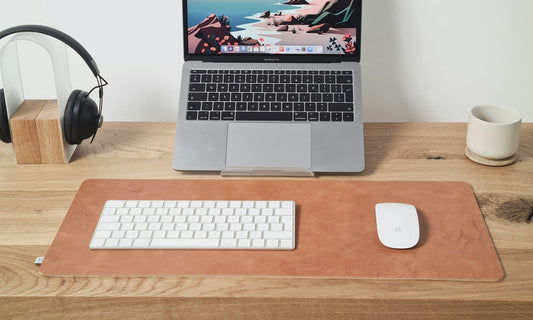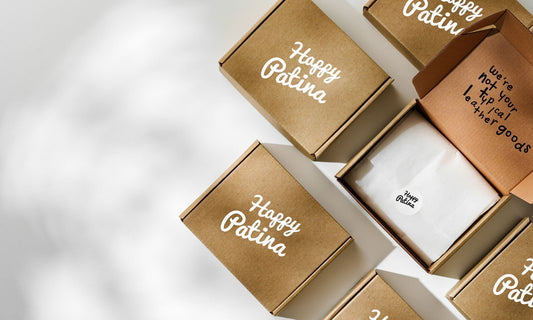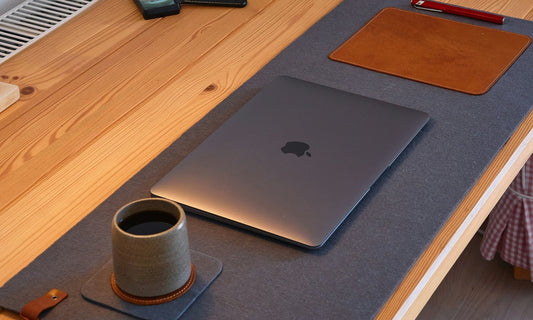
How to Maintain the Natural Patina of Leather Goods
Oscar Arenas- Understanding Leather Patina
- Why Patina Matters
- How Patina Develops: The Science of Aging Leather
- The Art of Maintenance — Caring Without Over-Correcting
- What to Avoid — Protecting Patina Naturally
- Recommended Leather Care Tools
- When to Seek Professional Restoration
- The Emotional Value of Patina
- FAQs
Leather is one of the few materials that doesn’t deteriorate with time — it evolves. With every touch, every fold, and every ray of light, it grows more personal. This slow transformation is known as patina, and it is what gives genuine leather its soul.
At HappyPatina, we believe that patina is not just a surface effect, but a dialogue between you and the object. It’s a record of moments, a story etched into texture and tone. Maintaining it doesn’t mean preserving it in stasis; it means guiding it with care so that it ages gracefully — just like the person who uses it.
1. Understanding Leather Patina
Patina is the visual and tactile evolution that occurs when vegetable-tanned leather interacts with light, air, and human touch. Over time, the surface develops a soft sheen and deeper color, creating an unmistakable warmth that synthetic materials can never replicate.
In its early stages, leather might look matte or pale. As it ages, it begins to darken slightly — particularly in the areas most exposed to use. The result is a piece that feels alive, uniquely shaped by your habits, your environment, and even your skin chemistry.
Each wallet, folio, or tray from HappyPatina starts with a neutral tone, but no two will ever end up the same. That is the beauty of authenticity: evolution, not repetition.
Patina is proof of presence — the visible trace of time well spent.
2. Why Patina Matters
In a world that glorifies the new, patina celebrates continuity. It’s the antithesis of planned obsolescence. Instead of losing value with time, vegetable-tanned leather gains richness, depth, and individuality.
For centuries, artisans have valued this transformation as the true hallmark of quality. A well-aged piece tells stories that factory perfection cannot — of journeys taken, tables shared, and work completed.
When you choose leather that changes, you’re choosing a living material — one that invites care, awareness, and appreciation. That is why maintaining patina isn’t about protection from time, but partnership with it.
Objects that evolve remind us to evolve too — with grace, with patience, and with meaning.
3. How Patina Develops: The Science of Aging Leather
Patina is a combination of oxidation (interaction with oxygen and light) and absorption (of oils and moisture). As leather breathes, its fibers flex and adapt, creating a soft glow. This is a natural process — no coating or chemical can truly imitate it.
The four main forces that shape patina are:
- Light: Sunlight stimulates the tannins in vegetable-tanned leather, deepening color and warmth.
- Touch: The oils from your hands nourish the surface, creating a smoother and softer texture.
- Movement: Daily friction polishes raised areas, enhancing contrast and depth.
- Environment: Temperature and humidity influence how fast the leather ages — dry air accelerates oxidation, while moisture keeps fibers supple.
Every interaction contributes to its individuality. Two identical wallets, given to two different people, will become entirely distinct after a year. That’s the power of living materials: they adapt to you.
4. The Art of Maintenance — Caring Without Over-Correcting
There’s a misconception that caring for leather means keeping it “as new” as possible. In reality, over-care can be as damaging as neglect. Vegetable-tanned leather doesn’t need to be polished to a mirror finish — it needs to be nourished just enough to breathe freely.
Routine Care (Every 1–2 Weeks)
- Wipe gently with a clean, soft cloth to remove dust and surface residue.
- Inspect edges and seams — they should feel smooth, not sticky or dry.
- Allow your leather to rest in an open space; avoid keeping it closed in a drawer constantly.
Monthly Ritual
- Apply a thin layer of neutral conditioner using circular motions and a soft cloth.
- Let the leather absorb naturally — never rub aggressively.
- Buff lightly with a dry cloth to restore natural luster.
Seasonal Deep Care (Every 3–6 Months)
- Clean with a slightly damp (not wet) cloth if needed — water alone, no soap or alcohol.
- Apply conditioner evenly across the entire surface, including hidden folds.
- Let it dry in a cool, shaded area for 24 hours.
Tip: Think of care as a ritual, not a chore. The few minutes you dedicate to it are an act of mindfulness — a reminder to slow down and honor what you own.
5. What to Avoid — Protecting Patina Naturally
Patina thrives when the leather is allowed to live naturally, without artificial interference. Here’s what to avoid if you want your piece to age with honesty:
- Avoid over-conditioning: Too much product can clog pores and flatten texture.
- No synthetic sprays or waxes: They seal the surface and stop the leather from breathing.
- Never use heat to dry: Direct heat damages fibers; let moisture evaporate slowly.
- Don’t store in plastic: Leather needs air circulation. Use cotton dust bags or natural linen covers.
- Keep away from perfumes and alcohol: These can stain or discolor the finish.
Remember, patina is fragile yet resilient — it thrives under gentle handling but fades under pressure. Care is not control; it’s cooperation.
6. Recommended Leather Care Tools
We design our care products to work in harmony with vegetable-tanned leather — neutral, natural, and effective.
- Leather Care Kit – Medium — includes conditioner, brush, and cloth for regular maintenance.
- Neutral Leather Conditioner — nourishes without altering tone or texture.
All our formulas are colorless, silicone-free, and tested to enhance the natural aging process without adding artificial shine.
Our approach to care mirrors our approach to craft — minimal, respectful, and timeless.
7. When to Seek Professional Restoration
Even the best-cared-for leather can need a professional touch after years of use. Seek a specialist if you notice:
- Deep scratches or cracks that expose raw fibers.
- Persistent stains that resist gentle cleaning.
- Areas that feel stiff, waxy, or overly dry.
A professional can rehydrate fibers, rebalance oils, and restore natural sheen — without removing the patina you’ve built. Avoid quick fixes like heavy waxes or repainting; they erase the history you’ve written on the surface.
8. The Emotional Value of Patina
Beyond aesthetics, patina is an emotional marker — it tells your story back to you. Each trace of wear captures a season of life: the wallet that darkened through years of travel, the desk pad that reflects the hours you’ve worked and dreamed upon it.
Patina teaches patience. It rewards consistency and mindfulness — qualities that, like craftsmanship, can’t be rushed. That’s why, at HappyPatina, we call our pieces “living leather”: they breathe, respond, and accompany you through time.
The goal isn’t to stop change — it’s to make sure it happens beautifully.
Key Takeaways
- Patina is the natural evolution of vegetable-tanned leather through light, touch, and time.
- Proper maintenance keeps it supple and luminous without halting its growth.
- Clean gently, condition sparingly, and let the leather breathe.
- Authentic care is about respect, not perfection.
- Every HappyPatina piece is designed to age gracefully — a reflection of a life well lived.
FAQs
Can I use shoe polish or wax on vegetable-tanned leather?
No. Shoe polishes often contain pigments and synthetic waxes that seal the surface, preventing the leather from breathing and aging naturally. Use neutral conditioners only.
Why does my leather darken unevenly?
Uneven darkening is natural. Different areas receive varying amounts of light and contact, creating unique tonal variations — the hallmark of genuine patina.
How often should I condition my HappyPatina accessories?
Every 4–6 weeks is ideal, depending on use and climate. In dry environments, more frequent conditioning may help maintain flexibility.
Can leather ever stop developing patina?
If sealed with heavy coatings or synthetic treatments, yes — the surface stops evolving. That’s why we use only natural vegetable-tanned leather that stays alive for decades.
Explore More Guides
- Materials & Care 101 — Understanding Vegetable-Tanned Leather
- The Living Leather Method™ — Our Way of Crafting Timeless Goods
- A Life Well Crafted — The Philosophy Behind HappyPatina
Final Thoughts
Patina is not decoration — it’s memory. It tells you that time has passed, that use has meaning, and that beauty doesn’t always come instantly.
With gentle attention, your HappyPatina piece will continue to evolve in color and character, becoming something more than you bought — something that belongs to you, and only you.
Shop the Leather Care Collection →



